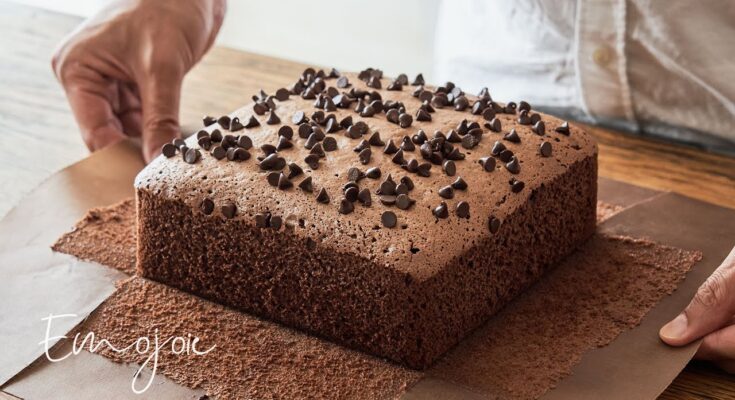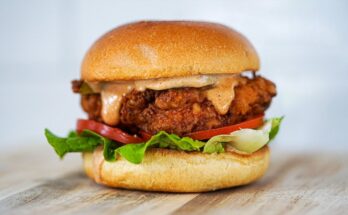Castella Cake Recipe: Ever had a cake so soft, so fluffy, and so irresistibly moist that you wanted to eat the entire loaf in one sitting? That’s exactly what the Castella cake does to you. This golden-brown, jiggly sponge cake has been a staple in Japanese bakeries for centuries. Originally brought over by Portuguese merchants in the 16th century, it evolved into the famous Kasutera we know and love today in Japan.
Unlike Western sponge cakes that are often layered with cream or frosting, Castella cake shines in its simplicity. Just a few basic ingredients—eggs, sugar, flour, and a hint of honey—come together to create this soft, bouncy delight. The magic is all in the technique. And don’t worry, we’re going to walk through each step together.
This guide will help you master the art of Castella cake making, even if you’re a total beginner. Whether you’re baking for a special occasion or just want a cozy treat with your tea, this recipe is foolproof. Let’s dive right in!
What Is Castella Cake?
Castella cake, also known as Kasutera in Japan, is a traditional Japanese sponge cake made with only a handful of ingredients. It’s known for its fine, moist crumb and bouncy texture that almost melts in your mouth. The top crust is typically a beautiful caramelized golden brown, and the interior has a subtle sweetness that comes from honey.
What sets Castella apart from other sponge cakes is its baking technique. It’s not just about whipping eggs and baking them. The batter is treated with precision. The texture is much tighter and more uniform than a typical chiffon or Genoise cake.
Interestingly, Castella cake doesn’t use any baking powder or baking soda. Instead, it relies entirely on the air beaten into the eggs to rise. This gives it a naturally light and fluffy finish without being dry or crumbly.
If you’ve ever tasted Japanese desserts before, you’ll recognize that signature balance: not too sweet, always elegant, and addictive in the best way. And while it might look fancy, it’s surprisingly simple to make once you get the steps right.
Ingredients You’ll Need
Here’s the full list of ingredients required to make a traditional Castella cake. Quality matters here, so choose the best you can get, especially when it comes to eggs and honey.
Core Ingredients:
- 6 large eggs (room temperature)
- 150g (¾ cup) granulated sugar
- 100g (¾ cup) bread flour (sifted)
- 2 tbsp honey (dissolved in 1 tbsp warm water)
- 2 tbsp milk (optional, for added moisture)
Why These Ingredients?
- Eggs: This is the base of the structure. You need large, fresh eggs.
- Sugar: Granulated sugar gives sweetness and helps in stabilizing the egg whites.
- Bread Flour: This has more protein than cake flour, giving Castella its signature chewy texture.
- Honey: Adds flavor and keeps the cake moist.
- Milk: A little splash of milk can make the texture creamier, though it’s optional.
Pro Tip: Do not substitute bread flour with all-purpose flour unless absolutely necessary. Bread flour is key to achieving that stretchy, dense-yet-soft texture Castella is famous for.
Tools and Equipment Required
You don’t need fancy gadgets, but a few tools will make your job a whole lot easier:
Essential Tools:
- Stand mixer or electric hand mixer
- 8×8 inch (20x20cm) square baking pan
- Mixing bowls
- Fine-mesh sieve (for flour)
- Spatula (silicone preferred)
- Parchment paper
- Kitchen scale (for accuracy)
- Oven thermometer
- Water bath tray
Optional But Helpful:
- Cake leveler (for even slicing)
- Cooling rack
- Toothpick/skewer (for doneness test)
- Pastry brush (for honey glaze, if using)
Make sure everything is clean and dry before starting. Even a little grease in your mixing bowl can prevent the eggs from whipping properly.
Prepping for the Recipe
Before we start mixing, let’s set the stage right.
1. Preheat the Oven:
Set your oven to 320°F (160°C). Place the oven rack in the center.
2. Prepare the Pan:
Line your square baking pan with parchment paper. Let the paper extend over the sides so you can easily lift the cake out later. Make sure there are no wrinkles, or your cake sides might not be smooth.
3. Water Bath Setup:
Castella is baked in a water bath to ensure gentle, even heating. Place your lined baking pan inside a larger tray. You’ll add hot water to the outer tray just before baking.
4. Room Temperature Ingredients:
Bring your eggs and milk to room temperature. Cold eggs won’t whip up as nicely, and your batter could split.
5. Sift the Flour:
Sift your bread flour twice. This ensures there are no lumps and gives you that ultra-smooth texture.
Step-by-Step Guide to Make Castella Cake
Alright, let’s make that perfect Castella cake. Follow these steps closely, and you’ll be amazed at the results.
Step 1: Mixing the Egg Yolk Base
Begin by separating the eggs. In a large bowl, whisk 5 egg yolks with ⅓ cup of sugar until pale and thick. Gradually add ¼ cup of honey mixed with 2 tablespoons of warm milk, then sift in ¾ cup of cake flour. Mix gently until smooth and lump-free. This forms the rich, velvety base of your Castella batter.
Step 2: Beating the Egg Whites to Stiff Peaks
In a clean bowl, beat 5 egg whites on medium speed until foamy. Slowly add ¼ cup of sugar in small portions, continuing to beat until stiff, glossy peaks form. The meringue gives the cake its light, fluffy structure.
Step 3: Folding Egg Whites into the Batter Correctly
Add one-third of the meringue to the yolk mixture and fold gently with a spatula to lighten the batter. Add the rest in two more additions, folding carefully to avoid deflating the air bubbles—this is key to achieving that signature spongy texture.
Step 4: Baking Technique Using the Water Bath Method
Pour the batter into a lined loaf pan, tap gently to remove air pockets, and place it in a larger pan filled with hot water. Bake at 320°F (160°C) for 50–60 minutes until golden and springy. Cool slightly before slicing—soft, moist perfection in every bite.
Tips for the Perfect Texture
If you’re chasing that signature silky-smooth texture of authentic Castella cake, then technique is everything. Even though the ingredients are basic, the results can wildly differ if you don’t follow a few golden rules. Let’s break them down.
1. Beat the Egg Whites Just Right
Your egg whites are the powerhouse behind the lift of this cake. Under-beaten, and the cake won’t rise. Over-beaten, and they’ll break down, causing a cracked, dense disaster. Aim for glossy stiff peaks—when you lift your beaters, the peak should stand up firm and proud, with a slight curve.
2. Gentle Folding Is Key
Don’t stir. Don’t beat. You need to fold the flour and egg yolks in gently using a spatula. Over-mixing deflates the batter and makes the cake tough. Imagine you’re folding a bedsheet: slow, steady, and with care.
3. Temperature Control Matters
Use an oven thermometer to make sure your oven is the right temperature. Many home ovens run hotter or colder than the dial says, and Castella is sensitive to changes. If it’s too hot, it’ll rise too fast and collapse. Too cold, and it’ll be undercooked in the middle.
4. Use the Water Bath Method
The water bath isn’t just for show—it’s crucial. It ensures the cake bakes gently and evenly without harsh direct heat. This keeps the texture bouncy and prevents cracks from forming.
5. Let It Rest Overnight
One of the secrets to a perfect Castella cake? Wrap it in plastic wrap and let it rest overnight in the fridge. The texture improves, the flavors settle, and it becomes even more moist and flavorful.
Want that iconic sticky top crust? Some bakers flip the cake upside down right after baking and let it cool that way. It flattens the top and creates that honey-glazed look.
Serving Suggestions
Castella cake is an experience, not just a dessert. You can enjoy it plain, but why not get a little creative with your presentation?
1. Simple Slices with Tea
The classic way to serve Castella is to slice it into thick rectangular pieces and enjoy it with a cup of green tea or matcha. The subtle bitterness of the tea pairs perfectly with the gentle sweetness of the cake.
2. Add a Dusting of Powdered Sugar
A light sprinkle of powdered sugar can dress it up without overwhelming its delicate flavor.
3. Fresh Fruit Toppings
Top it with slices of fresh strawberries, kiwi, or peaches for a refreshing twist. Want something creamier? A dollop of whipped cream on the side works wonders.
4. Drizzle with Honey or Condensed Milk
Take the sweetness up a notch with a light drizzle of honey, maple syrup, or condensed milk right before serving. It’s indulgent, but worth it.
5. Serve Chilled or Warm
Castella tastes amazing chilled from the fridge for a denser bite, or lightly warmed for a softer, melt-in-your-mouth experience.
This cake is perfect for afternoon tea, birthdays, brunches, or just when you’re craving something comforting and not too sweet.
Storing Your Castella Cake
You baked the perfect Castella—now how do you keep it that way?
Short-Term Storage (1–3 Days)
- Once completely cool, wrap it tightly in plastic wrap or store in an airtight container.
- Keep it at room temperature if your kitchen is cool and dry.
Refrigeration (Up to 7 Days)
- For longer storage, pop it into the fridge.
- Again, wrap it well to prevent it from drying out or absorbing fridge odors.
- Bring it to room temperature before serving, or warm it slightly for a softer bite.
Freezing (Up to 1 Month)
- Yes, Castella freezes beautifully!
- Wrap individual slices in plastic wrap, then place them in a freezer-safe bag.
- To serve, thaw overnight in the fridge or let sit at room temp for 1–2 hours.
Pro Tip: Castella often tastes even better the next day. Letting it rest overnight enhances both texture and flavor, making it richer and more cohesive.
Variations of Castella Cake
Once you’ve mastered the classic version, you can start getting creative. Here are some fun and delicious Castella cake variations to try:
1. Matcha Castella
- Add 1–2 tablespoons of matcha powder to the sifted flour.
- It gives a subtle earthy bitterness that balances the sweetness.
- Great with a cup of hot sencha tea.
2. Chocolate Castella
- Mix in 2 tablespoons of cocoa powder with the flour.
- Optionally, add some mini chocolate chips for extra decadence.
- A kid favorite and perfect for chocoholics.
3. Brown Sugar Castella
- Replace granulated sugar with Japanese kurozato (black sugar) or dark brown sugar.
- It gives a rich, caramel-like depth that pairs wonderfully with coffee.
4. Coffee Castella
- Add 1 tablespoon of instant espresso powder dissolved in warm water.
- Ideal for breakfast or afternoon pick-me-ups.
5. Honey Lemon Castella
- Use lemon zest and a few drops of lemon juice in the honey mixture.
- Bright and fragrant, this version is perfect for spring or summer.
These small tweaks open up a world of flavor while still keeping that iconic texture intact.
Common Mistakes to Avoid
Even seasoned bakers can trip up with Castella. Here are the most common pitfalls and how to dodge them:
1. Overbeating or Underbeating Egg Whites
- Overbeaten whites = dry, cracked top.
- Underbeaten whites = flat, dense cake.
- Solution: Beat to stiff peaks—glossy, firm, but not dry or clumpy.
2. Skipping the Water Bath
- Baking without a water bath can result in uneven baking, cracked tops, and dry texture.
- Always use the bain-marie method.
3. Mixing Too Harshly
- Stirring or aggressive folding will deflate your batter and ruin the airy texture.
- Be gentle and deliberate when combining.
4. Not Sifting Flour
- Lumps = uneven batter = inconsistent texture.
- Sift flour at least twice before adding.
5. Removing from Oven Too Early
- Castella is slow-baked and needs time.
- Opening the oven door early or cutting the time short will collapse the cake.
6. Using the Wrong Pan Size
- If your pan is too small, the batter overflows.
- Too big, and the cake bakes too thin and dries out.
Remember: Every step in Castella baking has a purpose. Follow the process carefully, and you’ll be rewarded with a bakery-quality cake.
Nutritional Information (Per Serving)
While Castella cake is a lighter dessert option compared to frosted or cream-filled cakes, it’s still important to know what you’re eating—especially if you’re keeping an eye on your nutrition.
Here’s a breakdown for one slice (based on 10 servings per loaf):
| Nutrient | Amount per Serving |
|---|---|
| Calories | 180–210 kcal |
| Carbohydrates | 30–35 g |
| Sugar | 18–22 g |
| Protein | 5–6 g |
| Fat | 3–5 g |
| Cholesterol | 70–90 mg |
| Fiber | <1 g |
| Sodium | 60–80 mg |
Key Takeaways:
- Low in fat, especially if no milk or butter is added.
- High in protein due to eggs, but also moderately high in sugar.
- Great for a light treat but maybe not an everyday indulgence if you’re on a strict diet.
Want to cut down the sugar? You can reduce it by 10–15%, but keep in mind that sugar also affects the structure and moisture of the cake. So tweak with caution!
Gluten-Free or Dairy-Free Alternatives
Trying to enjoy Castella cake with dietary restrictions? No problem. Here are some tested substitutes to make it work:
Gluten-Free Castella Cake
- Replace bread flour with a gluten-free flour blend designed for baking.
- Add ½ tsp xanthan gum to mimic the structure that gluten provides.
- Note: Texture might be slightly less stretchy, but still soft and moist.
Dairy-Free Castella Cake
- Omit milk or replace it with plant-based milk (almond, oat, or soy).
- Use maple syrup or agave instead of honey if vegan (though this changes flavor slightly).
- The cake is naturally dairy-free if you skip the optional milk.
Egg-Free Version?
Unfortunately, no. Eggs are critical for the rise, flavor, and structure of Castella cake. An eggless version would be an entirely different cake altogether.
If you’re looking for a similar texture in an eggless format, consider Japanese tofu-based cakes or soft steamed sponge cakes.
FAQs about Castella Cake Recipe
1. Can I make mini Castella cakes in muffin tins?
Yes! Just reduce the baking time to about 20–25 minutes. Still use a water bath, and monitor closely. They’re perfect for gifting or portion control.
2. How do I get that sticky caramel top like in store-bought Castella?
Bake the cake upside down or glaze the top with a honey-water mixture immediately after baking, then wrap and rest overnight.
3. What’s the best way to slice Castella cake cleanly?
Use a sharp serrated knife dipped in hot water. Wipe the blade between slices for neat edges.
4. Why is bread flour used instead of cake flour?
Bread flour gives Castella its signature bounce and dense, chewy structure. Cake flour would make it too soft and crumbly.
5. Can I add fillings like red bean paste or custard?
Traditionally, no—but you can experiment! Just remember fillings may affect baking time and structure, so start with small amounts.
Conclusion
There’s something magical about a cake that’s so simple yet so refined. Castella cake is not just a recipe—it’s an art form. With only a handful of ingredients and a little patience, you can create a dessert that rivals the best bakeries in Japan. Whether you enjoy it plain, with tea, or topped with fruits and creams, it always delivers comfort and elegance in every bite.
The real secret? Respect the process. Take your time to sift, fold, and bake with care. It’s not about perfection—it’s about the joy of making something with your hands, watching it rise gently in the oven, and sharing it with someone you love (or enjoying it all yourself—no judgment!).
So the next time you’re in the mood for something sweet but not too heavy, give this Castella cake recipe a try. It just might become your new favorite.



